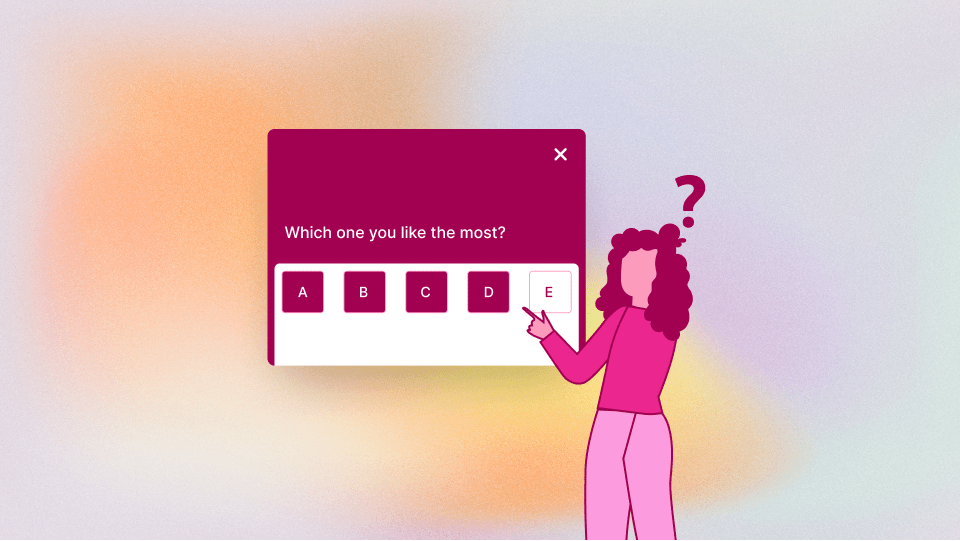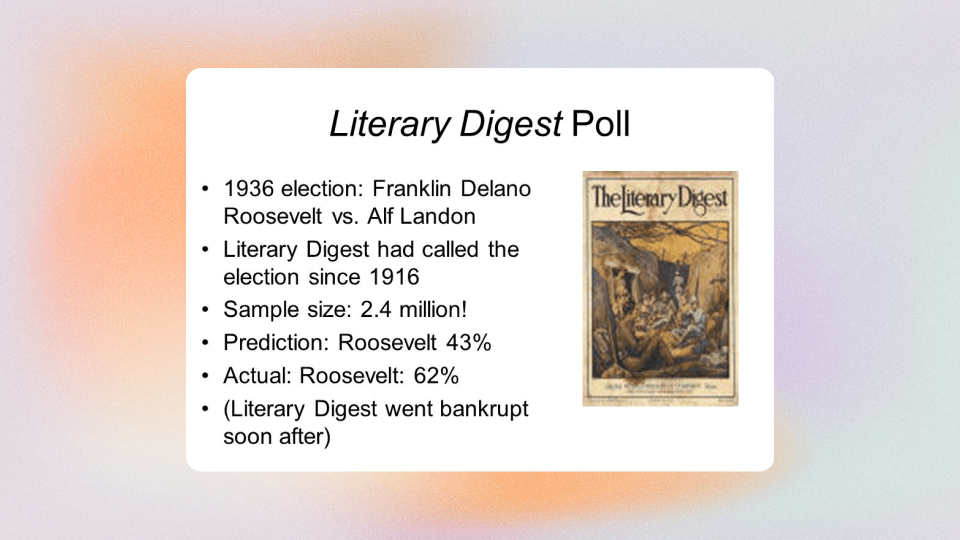Imagine walking into a room filled with people and asking them a simple question, only to realize that the answers you receive may not be entirely truthful. It sounds like a mystery. Well, that's precisely the mysterious world of response bias.
While conducting surveys and research, we often find ourselves grappling with the issue of response bias, which can be as subtle as a whisper yet as powerful as a hurricane when it comes to skewing our results.
You might be surprised to learn that, according to Wikipedia, response bias can account for as much as 10–70% of the variance in participant response. As we delve deeper into the complexities and intricacies of this phenomenon, you'll discover how response bias can manifest in various ways, leading to less accurate or even misleading outcomes.
So, let's get started!
What Is A Response Bias?
Response bias is an error that occurs in research when participants' answers are influenced by factors unrelated to the question. It can lead to misleading or inaccurate results.
There are many causes of response bias, including how questions are phrased, social desirability, and the order in which questions are presented.
Types Of Response Bias
Response biases can be of various types but here are some of the most common ones you should know.
1. Acquiescence Bias
Often referred to as "yea-saying," acquiescence bias occurs when respondents agree with statements or questions, irrespective of their true beliefs. It happens when individuals seek to avoid confrontation or take the path of least resistance. It's like nodding in a conversation, even when unsure of what's being discussed.
Acquiescence bias can significantly impact survey results, painting an overly optimistic picture of a situation that might not align with reality.
2. Social Desirability Bias
Picture yourself when you're asked about your eco-friendly habits or exercise routine. Naturally, you might be tempted to present yourself in the best possible light.
Social desirability bias arises when respondents feel pressured to provide answers others will view favorably, even if it means deviating from the truth. This bias can lead to a distorted understanding of public opinion and skew the results of social research.
3. Leading Question Bias
How a question is framed can sometimes lead respondents to provide answers that align with the implied expectation.

Leading question bias occurs when survey questions contain cues, hints, or suggestions that subtly steer respondents toward a specific answer. This bias can result from poorly constructed questions or even intentional manipulation, resulting in data that does not accurately reflect the respondents' beliefs.
4. Sampling Bias
Selecting a representative population sample is crucial when conducting a survey or study. However, sampling bias occurs when the chosen sample does not accurately represent the larger population.
Sampling bias can emerge from various factors, such as non-random selection or unrepresentative demographic breakdowns, leading to misleading conclusions about the population.
5. Question Order Bias
Surprisingly, even the order in which questions are presented can impact the responses received. Question order bias occurs when the placement of a question influences the respondent's answer due to the context established by earlier questions.
Question order bias can lead to a situation where answers are affected by the thought processes triggered by previous questions rather than reflecting the respondent's independent opinions.
6. Interviewer Bias
The human touch can sometimes leave an unintentional mark. For example, interviewer bias occurs when the interviewer's presence, characteristics, or behavior influence the respondent's answers.
This bias could result from unconscious cues, verbal or non-verbal communication, or even the interviewer's appearance, leading to altered responses that may not accurately represent the respondent's true opinions.
Response Bias Example (Explained In 4 Parts)
Part 1: The Survey Design And Methodology
In 1936, The Literary Digest, a popular magazine, conducted a presidential election poll to predict the winner between Franklin D. Roosevelt and Alf Landon. The survey was based on mailed-in ballots and targeted over 10 million people, a large sample.
Part 2: Biases In The Survey
The survey suffered from non-response bias and selection bias. The magazine's readership was skewed towards higher-income individuals, and it drew its mailing list from sources such as:
- Telephone directories;
- Automobile registration lists;
- Club membership lists.
It led to a biased sample, excluding lower-income people less likely to own a car or a telephone. The response rate was also relatively low, with only about 2.4 million participating.
Part 3: Impact Of Biases On Results
As a result of these biases, The Literary Digest predicted a landslide victory for Landon, who lost by a large margin to Roosevelt. The incorrect prediction seriously damaged the magazine's credibility and ceased publication within a few years.
Part 4: Lessons Learned From Example
The Literary Digest's poll failure is a cautionary tale for addressing response bias in survey research. The example highlights the need to carefully consider sample selection, response rates, and potential biases when designing surveys.
Ensuring that the sample is representative of the population of interest and that the questions are unbiased can help minimize the impact of response bias on research findings. Additionally, employing techniques like random sampling and anonymity can further reduce the influence of response bias.

How Does Response Bias Affect Your Surveys?
Surveys are indispensable for collecting data and gauging public opinion, but they can sometimes feel like navigating a minefield of potential pitfalls. As previously discussed, one of the most significant challenges you can face is response bias, which can manifest in various forms.
Now, let's delve into the implications of response bias and explore how it can affect your surveys and, ultimately, your decision-making process.
1. Impact On Data Quality And Reliability
Response bias can directly compromise the quality and reliability of the data collected in a survey. When respondents provide inaccurate or biased answers, the gathered information deviates from the actual beliefs or opinions of the studied population. As a result, it undermines the validity of the survey and can cast doubt on any conclusions drawn from the data.
In a world that increasingly relies on data-driven decision-making, the integrity of the data we collect is paramount, making it essential to identify and mitigate response bias to the best of our abilities.
2. Consequences For Decision-Making And Resource Allocation
Decisions based on biased survey data can have significant repercussions, particularly in policy-making, business strategies, and resource allocation.
When decision-makers rely on inaccurate or skewed data, they may channel resources into less effective initiatives or overlook more pressing issues.
For example, if a survey about public health priorities is affected by social desirability bias, it may lead to an overemphasis on popular issues while neglecting other critical concerns. Consequently, addressing response bias is crucial to ensuring that data-driven decisions lead to more effective and well-targeted outcomes.
3. Potential For Misleading Insights And Conclusions
The ultimate goal of any survey is to extract valuable insights and uncover hidden trends within a population. But unfortunately, response bias can muddy the waters, leading to misleading or even downright erroneous conclusions.
For instance, if a survey about employee satisfaction is affected by acquiescence bias, the results may falsely suggest a happy and content workforce, while the reality might differ.
Relying on such biased data can exacerbate existing problems and create new ones by misguiding decision-makers. Recognizing the potential dangers of response bias is the first step toward creating more accurate, reliable, and actionable insights from your surveys.
How To Avoid Response Bias?
Response bias can significantly impact the accuracy of research findings. Therefore, minimizing the influence of response bias in surveys and questionnaires is essential to obtain reliable and valid results.
Here are some practical steps you can take to avoid response bias:
1. Use Clear And Concise Language
Keep questions simple and easy to understand. Avoid using technical terms or jargon that participants may not be familiar with. Clear language helps ensure respondents understand the questions and provide accurate answers.
2. Develop Neutral And Balanced Questions
Avoid leading or loaded questions that may influence participants' responses. Instead, phrase questions neutrally and objectively so that respondents can freely express their opinions without feeling pressure to conform to a particular viewpoint.
3. Avoid Double-Barreled Questions
Double-barreled questions combine two topics into a single question, confusing respondents and leading to biased answers. Instead, break down such questions into separate, distinct items to ensure clarity and avoid misinterpretation.
4. Implement Appropriate Sampling Techniques
Select a representative sample of the population of interest using random or stratified sampling methods. It will help ensure that the responses collected are representative of the broader population and reduce the potential for selection bias.
5. Ensure Anonymity And Confidentiality
Assure respondents that you've kept their answers confidential, and their identities will remain anonymous. It encourages participants to provide honest and open responses, as they are less likely to fear judgment or repercussions.
6. Pretest And Pilot Surveys
Before administering a survey to the entire target population, conduct a pretest or pilot study with a small group of respondents. It allows you to identify any issues with the survey design, such as ambiguous or biased questions, and make necessary revisions before full-scale implementation.
7. Past Survey Analysis
Review previous surveys, both successful and unsuccessful, to identify potential sources of bias and learn from past mistakes. Stay up-to-date with the latest research and best practices in survey design to ensure that your methodology is as unbiased and effective as possible.
By avoiding response bias, you can improve the quality of their data and increase the validity of their findings.
Conclusion: Addressing Response Bias
Addressing response bias is a critical aspect of conducting reliable and accurate research. Ensuring that the data collected is free from bias allows researchers to draw meaningful insights and make informed decisions based on their findings. However, as we've discussed throughout, response bias can significantly affect the validity of results, making it crucial for researchers to work to minimize its impact actively.
Implementing the earlier strategies and employing appropriate sampling techniques will help you take significant steps toward reducing response bias in your surveys. In addition, ensuring anonymity, pretesting your survey, and learning from past research can further help refine your data collection approach.
Stay informed about the latest research and best practices, and continually refine your methods to ensure your surveys are as unbiased and effective as possible. Doing so will better equip you to draw meaningful conclusions from your research and make a lasting impact in your field.
Frequently Asked Questions (FAQs)
1. What is the most common response bias?
Acquiescence bias and social desirability bias are among the most frequently encountered types of response bias in various research settings.
2. What is an example of a non-response bias?
An example of non-response bias is when a survey about job satisfaction has a low response rate from employees who are too disengaged or dissatisfied to participate, leading to an overrepresentation of satisfied employees' opinions.
3. Is response bias lying?
Response bias is not necessarily lying. Instead, it encompasses a range of factors that can influence responses, such as social pressures or question framing. While some respondents might provide intentionally incorrect answers, others may be unintentionally swayed by these factors, leading to biased responses.


